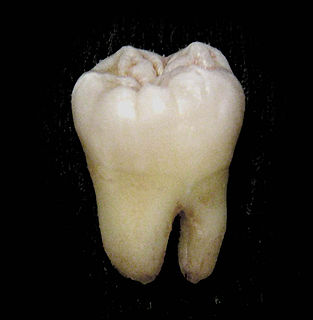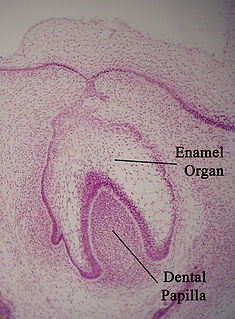
The human teeth function to mechanically break down items of food by cutting and crushing them in preparation for swallowing and digesting. Humans have four types of teeth: incisors, canines, premolars, and molars, which each have a specific function. The incisors cut the food, the canines tear the food and the molars and premolars crush the food. The roots of teeth are embedded in the maxilla or the mandible and are covered by gums. Teeth are made of multiple tissues of varying density and hardness.

The molars or molar teeth are large, flat teeth at the back of the mouth. They are more developed in mammals. They are used primarily to grind food during chewing. The name molar derives from Latin, molaris dens, meaning "millstone tooth", from mola, millstone and dens, tooth. Molars show a great deal of diversity in size and shape across mammal groups.
Lavanify is a mammalian genus from the late Cretaceous of Madagascar. The only species, L. miolaka, is known from two isolated teeth, one of which is damaged. The teeth were collected in 1995–1996 and described in 1997. The animal is classified as a member of Gondwanatheria, an enigmatic extinct group with unclear phylogenetic relationships, and within Gondwanatheria as a member of the family Sudamericidae. Lavanify is most closely related to the Indian Bharattherium; the South American Sudamerica and Gondwanatherium are more distantly related. Gondwanatheres probably ate hard plant material.

Cementum is a specialized calcified substance covering the root of a tooth. The cementum is the part of the periodontium that attaches the teeth to the alveolar bone by anchoring the periodontal ligament.

Dentin or dentine is a calcified tissue of the body and, along with enamel, cementum, and pulp, is one of the four major components of teeth. It is usually covered by enamel on the crown and cementum on the root and surrounds the entire pulp. By volume, 45% of dentin consists of the mineral hydroxylapatite, 33% is organic material, and 22% is water. Yellow in appearance, it greatly affects the color of a tooth due to the translucency of enamel. Dentin, which is less mineralized and less brittle than enamel, is necessary for the support of enamel. Dentin rates approximately 3 on the Mohs scale of mineral hardness. There are two main characteristics which distinguish dentin from enamel: firstly, dentin forms throughout life; secondly, dentin is sensitive.

Gigantopithecus is an extinct genus of ape from the Early to Middle Pleistocene of southern China, represented by one species, G. blacki. The remains of Gigantopithecus, two third molar teeth, were first identified in a drugstore by anthropologist Ralph von Koenigswald in 1935, who subsequently described the ape. In 1956, the first mandible and over 1,000 teeth were found in Liucheng, and numerous more remains have since been found in at least 16 sites. Only teeth and 4 mandibles are known currently, and other skeletal elements were likely consumed by porcupines before they could fossilise. Gigantopithecus was once argued to be a hominin, a member of the human line, but it is now thought to be closely allied with orangutans, classified in the subfamily Ponginae.
Hypsodont is a pattern of dentition with high-crowned teeth and enamel extending past the gum line, providing extra material for wear and tear. Some examples of animals with hypsodont dentition are cows and horses; all animals that feed on gritty, fibrous material. The opposite condition is called brachydont.
An enamel rod is the basic unit of tooth enamel. Measuring 4 μm wide to 8 μm high, an enamel rod is a tightly packed, highly organized mass of hydroxyapatite crystals, which are hexagonal in shape and provide rigidity to the rods and strengthen the enamel. In cross section, it is best compared to a keyhole with the top, or head, oriented toward the crown of the tooth and the bottom, or tail, oriented toward the root of the tooth.

Abfraction is a theoretical concept explaining a loss of tooth structure not caused by tooth decay. It is suggested that these lesions are caused by forces placed on the teeth during biting, eating, chewing and grinding; the enamel, especially at the cementoenamel junction (CEJ), undergoes large amounts of stress, causing micro fractures and tooth tissue loss. Abfraction appears to be a modern condition, with examples of non-carious cervical lesions in the archaeological record typically caused by other factors.

The enamel organ, also known as the dental organ, is a cellular aggregation seen in a developing tooth and it lies above the dental papilla. The enamel organ is responsible for the formation of enamel, initiation of dentine formation, establishment of the shape of a tooth's crown, and establishment of the dentoenamel junction.

Tooth development or odontogenesis is the complex process by which teeth form from embryonic cells, grow, and erupt into the mouth. For human teeth to have a healthy oral environment, all parts of the tooth must develop during appropriate stages of fetal development. Primary (baby) teeth start to form between the sixth and eighth week of prenatal development, and permanent teeth begin to form in the twentieth week. If teeth do not start to develop at or near these times, they will not develop at all, resulting in hypodontia or anodontia.
Ganodonta were a group of specialized North American Lower and Middle Eocene mammals of uncertain affinity. The group includes Hemiganus, Psittacotherium and Conoryctes from the Puerco, Calamodon and Hemiganus from the Wasatch, and Slylinodon from the Bridger Eocene. With the exception of Conorycles, in which it is longer, the skull is short and suggests affinity to the sloths, as does what little is known of the limb bones.
Dentin hypersensitivity is dental pain which is sharp in character and of short duration, arising from exposed dentin surfaces in response to stimuli, typically thermal, evaporative, tactile, osmotic, chemical or electrical; and which cannot be ascribed to any other dental disease.

Dental anatomy is a field of anatomy dedicated to the study of human tooth structures. The development, appearance, and classification of teeth fall within its purview. Tooth formation begins before birth, and the teeth's eventual morphology is dictated during this time. Dental anatomy is also a taxonomical science: it is concerned with the naming of teeth and the structures of which they are made, this information serving a practical purpose in dental treatment.

A tooth is a hard, calcified structure found in the jaws of many vertebrates and used to break down food. Some animals, particularly carnivores, also use teeth for hunting or for defensive purposes. The roots of teeth are covered by gums. Teeth are not made of bone, but rather of multiple tissues of varying density and hardness. The cellular tissues that ultimately become teeth originate from the embryonic germ layer, the ectoderm.
LACM 149371 is an enigmatic fossil mammalian tooth from the Paleogene of Peru. It is from the Santa Rosa fossil site, which is of uncertain age but possibly late Eocene or Oligocene. The tooth is poorly preserved and may have been degraded by acidic water or because it passed through a predator's digestive tract. Its largest dimension is 2.65 mm. It is triangular in shape and bears six cusps that surround the middle of the tooth, where there are three basins (fossae). Crests connects the cusps and separate the fossae. The microscopic structure of the enamel is poorly preserved.
Bharattherium is a mammal that lived in India during the Maastrichtian and possibly the Paleocene. The genus has a single species, Bharattherium bonapartei. It is part of the gondwanathere family Sudamericidae, which is also found in Madagascar and South America during the latest Cretaceous. The first fossil of Bharattherium was discovered in 1989 and published in 1997, but the animal was not named until 2007, when two teams independently named the animal Bharattherium bonapartei and Dakshina jederi. The latter name is now a synonym. Bharattherium is known from a total of eight isolated fossil teeth, including one incisor and seven molariforms.
The infundibulum of a tooth is the funnel-like center that is filled with cementum. The funnel is widest at the top (crown) which is the grinding (occlusal) surface. The infundibulum is also known as the dental cup. Simple tooth infundibula occur most notably in the incisors of horses and other equines, but they also occur in the premolars and molars of ruminants: camels, deer, horses and all bovids. The infundibula found in ruminants can get quite complex some with two funneling centers, and with multiple folding in the sides of the cup. These folds produce greater amounts of enamel in vertical curtains that substantially increase the durability of the tooth. The cheek teeth of elephants express this in a slightly different form with the vertical curtains of enamel coming in from the sides and meeting in the middle.
Cheek teeth or post-canines comprise the molar and premolar teeth in mammals. Cheek teeth are multicuspidate. Mammals have multicuspidate molars and premolars situated between canines and molars whose shape and number varies considerably among particular groups. For example, many modern Carnivora possess carnassials, or secodont teeth. This scissorlike pairing of the last upper premolar and first lower molar is adapted for shearing meat. In contrast, the cheek teeth of deer and cattle are selenodont. Viewed from the side, these teeth have a series of triangular cusps or ridges, enabling the ruminants' sideways jaw motions to break down tough vegetable matter. Cheek teeth are sometimes separated from the incisors by a gap called a diastema.

Dinosaur teeth have been studied since 1822 when Mary Ann Mantell (1795-1869) and her husband Dr Gideon Algernon Mantell (1790-1852) discovered an Iguanodon tooth in Sussex in England. Unlike mammal teeth, individual dinosaur teeth are generally not considered by paleontologists to be diagnostic to the genus or species level for unknown taxa, due morphological convergence and variability between teeth. and many historically named tooth taxa like Paronychodon and Richardoestesia are today considered nomina dubia, and are used as form taxa to refer to isolated teeth from other localities displaced considerably in time and space from the type specimens. However, it is possible to refer isolated teeth to known taxa provided that the tooth morphology is known and the teeth originate from a similar time and place.










